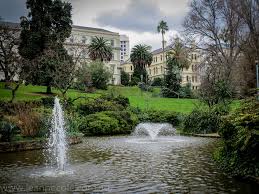The Parliamentary Precinct is located at the most western part of East Melbourne and on the city edge. The area was put aside as a government reserve by early planners of the city. It is the centre of state government and in the early days, the home of the Commonwealth of Australia for two decades from 1901 to 1927. Landmark buildings such as Parliament House and the Old Treasury building and other government office buildings collectively make up the Parliamentary Precinct of various architectural styles dating from the late 1840s.
Parliament House
110 -160 Spring Street
One of Melbourne’s finest classical buildings, Parliament House looks down Bourke Street into the heart of the city. Built in stages between 1856 and 1930, the final stage of which, the 150 foot dome, was never built. An imposing flight of stairs rise up to an entrance of majestic fluted doric columns.
Parliament Gardens
This triangular park is a small peaceful oasis for city office workers. Located beside the Houses of Parliament and bounded by Spring Street and Albert Street, the gardens feature the Coles fountain and statues of Pastor Sir Douglas and Lady Nicolls.
Gordon Reserve
This small reserve is located in Spring Street and named after General Gordon and Australian poet Robert Lindsay Gordon. The Stanford fountain was sculptured by convict William Stanford while in Pentridge prison in the 1860s.
Old Treasury Building
Another piece of grand architecture in Spring Street is the renaissance revival of the Old Treasury Building – erected between 1857 and 1862. Solid thick walls were designed to house the gold from Victoria’s mining towns.
Parliamentary Offices
At the rear of the Houses of Parliament and the Old Treasury Building and extending back to Lansdowne Street is a maze of government office buildings.

